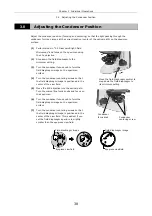
Chapter 2 Microscopy
2.4 Episcopic Microscopy (with the Epi Illuminator Option)
25
13
Switch to any desired objective
and view the specimen.
•
Each time you change objectives, the field
diaphragm and the condenser aperture
diaphragm must be adjusted.
For the bright-field microscopy, the field aperture
should be adjusted so that its image
circumscribes the view field. And the aperture
diaphragm should be 70% to 80% of the
numerical aperture of the objective.
⇒
P.51
⇒
P.52
•
Focus on the specimen again using the fine focus
knob or the coarse focus knob.
⇒
P.53
•
Use the ND filters on the epi illuminator to adjust
the brightness.
•
To use an oil immersion type objective or a water
immersion type objective, perform the oil
immersion or water immersion.
14
To perform the episcopic
polarization microscopy, insert the
polarizer slider into the place on
the side of the illuminator and
place the analyzer on the
intermediate tube into the optical
path.
•
The polarizer azimuth should be adjusted with
the ring on the polarizer slider. For the
adjustment method, see P.45.
•
To perform the conoscopic microscopy, move the
Bertrand lens into the optical path. (See “2.3
Conoscopic Observation.”)
15
To return to the bright-field microscopy
•
Turn off the power supply for the lamp.
•
Pull the illumination selection lever on the epi illuminator to set the dark-field position for it.
•
Turn on the power switch of the microscope to light the diascopic illumination.
•
Remove the analyzer and the Bertrand lens from the optical path.
16
Turn off all the power after completing the observation.
Focus on the
specimen
using the
coarse focus
knob and the
fine focus
knob.
Adjust the field diaphragm
and the aperture diaphragm.
Adjust the
brightness
with the
ND filters.
Switch to
any desired
objective.
Move the analyzer into
the optical path.
Move the polarizer into
the optical path.
Содержание Eclipse 50i POL
Страница 1: ...Polarizing Microscope ECLIPSE 50i POL Instructions M362E 05 8 NF 1 ...
Страница 2: ......






























